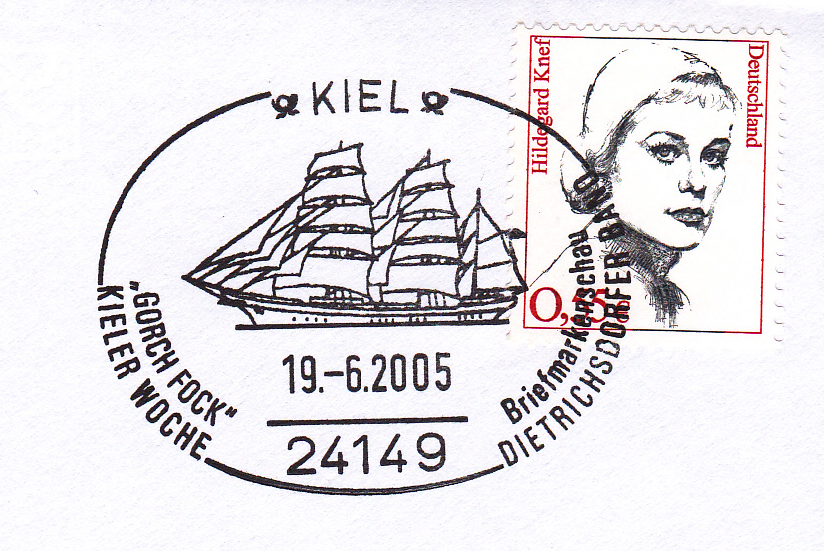|
4 German tall ships |
 |
| Dispossessed of its ships following the Treaty of
Versailles, the German Navy reconstitutes its fleet and orders four
sailing ships to Blohm and Voss yards in Hamburg. After the Second World
War, the four sailing ships built according to the same model of
3-masted barque, are seized by the
allied: Gorch Fock I (1933) is allotted to the USSR which names it
Tovaritch, Horst Wessel (1936) goes to the American coastguards under
the name of Eagle. Albert Leo Schlageter (1937) is allotted to Portugal
and becomes Sagres II. As for Mircea (1939), she is requisitioned by the
Red Army before being restored in Romania. After the loss of training ship NIOBE, a four-masted barque having capsized on 26 July 1932 in Baltic Sea close to Fehmarn, the German navy orders a new sailing ship, financed partly by a national subscription, launched on 3 May 1933 with the name of a German writer. GORCH FOCK is used as training ship until 1939. The ship is designed to be particularly robust and sure against the capsizing: more than 300 tons of steel of ballast in the skittle give her a sufficient capacity of rectification to bring back it in driving position, even if the slope is close to 90°. During the Second World War, she was stationed at Stralsund, before being transferred towards the island of Rügen, in April 1944, to take again missions of training in Baltic Sea . Returned at Straslund, GORCH FOCK, to avoid the capture by the Soviet troops, is scuttled on 30 April 1945 in the port. Soviet raised her in June 1947 and after important renovation work from 1948 to 1950 in the shipyard Neptun de Rostock, then in Wismar, she is named TOVARITCH (“comrade”, in Russian). Based at Odessa, she passed under Ukrainian flag in 1991 but she is disabled in 1993. Repaired in Wilhelmshaven, she is renamed GORCH FOCK and definitively transferred to Straslund in 2003, where she is opened to the visitors as museum. |
|||||
 |
 |
||||
| HORST WESSEL is launched at the shipyard Blohm & Voss of Hamburg on 13 June 1936. She is called after an assassinated Nazi officer. She was larger in dimension and her spars were all steel, unlike Gorch Fock's wooden yards. From the port of Kiel, on Baltic Sea, she served as training ship. In 1939, she is converted into cargo and wass equipped of two anti-aircraft guns, while continuing missions of training. Given to the United States, she is repaired and modified in Wilhelmshaven. On 15 May 1946, she is named EAGLE and joined her home port, New London in Connecticut. A permanent crew of 6 officers and 29 team-members maintain the ship and ensures the training for 150 cadets. | |||||
 |
 |
 |
|||
 |
|||||
| Albert Leo Schlageter damaged by a mine in Baltic Sea when carrying troops, is recovered by the Americans in 1945. Sold to Brazil, she is named Guanabara. In 1962, Portugal buys her to replace Sagres II, built in 1896 at Bremerhaven under the name of RICKMERS RICKMERS. This one becomes Santo Andre then Rickmer Rickmers;she is today a floating museum in Hamburg. First Sagres built in England in 1858 had been used as training ship from 1882 to 1898. The SAGRES (3rd of the name but called SAGRES II) is recognizable with the Red Cross onher sails. | |||||
 |
 |
||||
| RICKMERS RICKMERS today anchored in Hamburg | |||||
 |
 |
 |
|||
 |
|||||
| The barque MIRCEA is a training ship of the Rumanian navy (naval Academy of Constanza). She has two masts with square sails and a mizzenmast to fore-and-aft sail. She is used to train cadets officers or non-commissioned officers. The flags in garlands with the masts of the boat represent the values (fatherland, honor, health….) and colors of Romania (blue, yellow, red). MIRCEA sailed a long time in Black Sea and in the Mediterranean Sea, before taking part in 1976 to the celebration of US bicentenary. This vessel has 55 complete days endurance. | |||||
 |
 |
 |
|||
 |
|||||
| Ships characteristics (Source https://en.wikipedia.org except MIRCEA source https://www.anmb.ro/ro/files/bric/bric.html) | |||||
| GORCH FOCK | EAGLE | SAGRES | MIRCEA | ||
| Three masted barque, hull steel, lanched 3 May 1933 Length: 82.1 m (269 ft) Beam: 39 ft (12 m) Draught: 5.2 m (17 ft) Displacement: 1,510 long tons (1,534 t) full load Sail area: 18,870 sq ft (1,753 m2) |
Three masted barque, hull steel, 13 June 1936 Length: Overall: 295 ft (90 m) Beam: 39 ft (12 m) Draft: Full load: 17.5 ft (5.3 m) Displacement: Full load: 1,784 long tons (1,813 t) Sail area: 22,280 sq ft (2,070 m²) |
Three masted barque, hull steel, 30 October 1937 Length Overall: 89 m (292 ft) Beam: 39 ft (12 m) Draught: 5.2 m (17 ft 1 in) Displacement: 1,755 long tons (1,783 t) Sail area: 22,000 sq ft (2,000 m²) |
Three masted barque, hull steel, 22 September 1938 Length Overall: 81.36 m (267 ft) Beam: 39 ft (12 m) Draught: 5.35 m (17 ft) Displacement: 1,510 long tons (1,534 t) full load Sail area: 18,840 sq ft (1,750 m2) |
||
Home |
Click below for the pages list |
|
Page on line on:
|